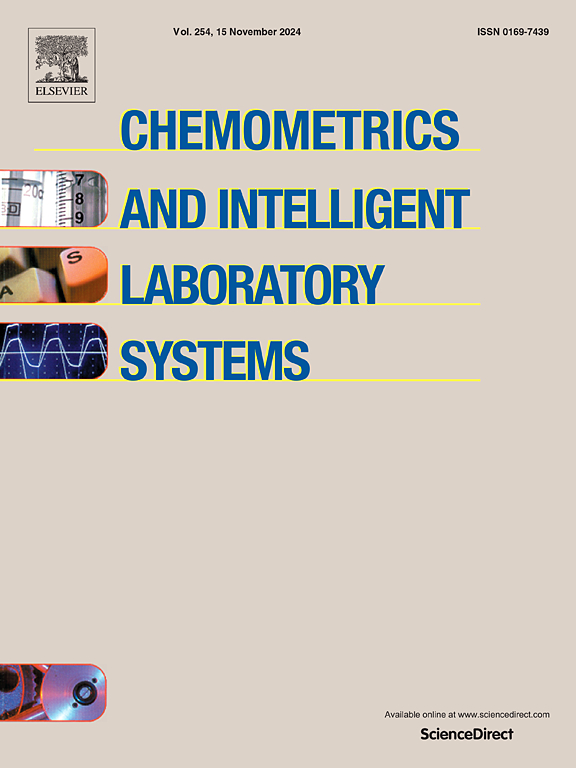AIPs-DeepEnC-GA: Predicting anti-inflammatory peptides using embedded evolutionary and sequential feature integration with genetic algorithm based deep ensemble model
IF 3.7
2区 化学
Q2 AUTOMATION & CONTROL SYSTEMS
Chemometrics and Intelligent Laboratory Systems
Pub Date : 2024-09-29
DOI:10.1016/j.chemolab.2024.105239
引用次数: 0
Abstract
Inflammation is a biological response to harmful stimuli including infections, damaged cells, tissue injuries, and toxic chemicals. It plays an essential role in facilitating tissue repair by eliminating pathogenic microorganisms. Currently, numerous therapies are applied to treat autoimmune and inflammatory diseases. However, these conventional anti-inflammatory medications are often labor-intensive, costly, and associated with adverse side effects. Recently, researchers have identified anti-inflammatory peptides (AIPs) as a cost-effective alternative for treating several inflammatory diseases, due to their high selectivity for target cells with minimal side effects. In this study, we introduce a novel computational predictor, AIPs-DeepEnC-GA, developed to accurately predict AIP samples. The training sequences are encoded using a novel n-spaced dipeptide-based position-specific scoring matrix (NsDP-PSSM) and Pseudo position-specific scoring matrix (PsePSSM)-based embedded evolutionary features. Additionally, the reduced-amino acid alphabet (RAAA-11), and composite Physiochemical properties (CPP) are employed to capture cluster-physiochemical properties based on structural information. A hybrid feature strategy is then applied, integrating embedded evolutionary features, CPP and RAAA-11 descriptors to overcome the limitations of individual encoding methods. Minimum redundancy and maximum relevance (mRMR) is utilized to select the optimal features. The selected features are trained using four different deep-learning models. The predictive labels generated by these models are provided to a genetic algorithm to form a deep-ensemble training model. The proposed AIPs-DeepEnC-GA model achieved a ∼15 % increase in predictive accuracy, reaching 94.39 %, and a 19 % improvement in the area under the curve (AUC), achieving a value of 0.98 using training sequences. For independent datasets, our method obtained improved accuracies of 91.87 %, and 89.21 %, with AUC values of 0.94 and 0.92 for Ind-I, and Ind-II, respectively. Our proposed AIPs-DeepEnC-GA model demonstrates an 11 % improvement in predictive accuracy over existing AIPs computational models using training samples. The efficacy and reliability of this model make it a promising tool for both in drug development and research academia.
AIPs-DeepEnC-GA:利用基于遗传算法的嵌入式进化和序列特征集成深度集合模型预测抗炎肽
炎症是对有害刺激(包括感染、受损细胞、组织损伤和有毒化学物质)的一种生物反应。它在通过消除病原微生物促进组织修复方面发挥着重要作用。目前,治疗自身免疫性和炎症性疾病的疗法很多。然而,这些传统的抗炎药物往往耗费大量人力、物力和财力,而且还伴有不良副作用。最近,研究人员发现,抗炎肽(AIPs)对靶细胞具有高度选择性,且副作用极小,是治疗多种炎症性疾病的一种经济有效的替代疗法。在这项研究中,我们介绍了一种新型的计算预测器 AIPs-DeepEnC-GA,它可以准确预测 AIP 样品。训练序列使用基于n-间隔二肽的新型位置特异性评分矩阵(NsDP-PSSM)和基于伪位置特异性评分矩阵(PsePSSM)的嵌入式进化特征进行编码。此外,还采用了还原氨基酸字母表(RAAA-11)和复合生化特性(CPP),以捕捉基于结构信息的集群生化特性。然后采用混合特征策略,整合嵌入式进化特征、CPP 和 RAAA-11 描述符,以克服单个编码方法的局限性。利用最小冗余和最大相关性(mRMR)来选择最佳特征。选定的特征使用四种不同的深度学习模型进行训练。这些模型生成的预测标签将提供给遗传算法,以形成一个深度集合训练模型。所提出的 AIPs-DeepEnC-GA 模型的预测准确率提高了 15%,达到 94.39%,曲线下面积(AUC)提高了 19%,使用训练序列的曲线下面积值达到 0.98。对于独立数据集,我们的方法提高了 91.87 % 和 89.21 % 的准确率,Ind-I 和 Ind-II 的 AUC 值分别为 0.94 和 0.92。与使用训练样本的现有 AIPs 计算模型相比,我们提出的 AIPs-DeepEnC-GA 模型的预测准确率提高了 11%。该模型的有效性和可靠性使其在药物开发和学术研究中都成为一种很有前途的工具。
本文章由计算机程序翻译,如有差异,请以英文原文为准。
求助全文
约1分钟内获得全文
求助全文
来源期刊
CiteScore
7.50
自引率
7.70%
发文量
169
审稿时长
3.4 months
期刊介绍:
Chemometrics and Intelligent Laboratory Systems publishes original research papers, short communications, reviews, tutorials and Original Software Publications reporting on development of novel statistical, mathematical, or computer techniques in Chemistry and related disciplines.
Chemometrics is the chemical discipline that uses mathematical and statistical methods to design or select optimal procedures and experiments, and to provide maximum chemical information by analysing chemical data.
The journal deals with the following topics:
1) Development of new statistical, mathematical and chemometrical methods for Chemistry and related fields (Environmental Chemistry, Biochemistry, Toxicology, System Biology, -Omics, etc.)
2) Novel applications of chemometrics to all branches of Chemistry and related fields (typical domains of interest are: process data analysis, experimental design, data mining, signal processing, supervised modelling, decision making, robust statistics, mixture analysis, multivariate calibration etc.) Routine applications of established chemometrical techniques will not be considered.
3) Development of new software that provides novel tools or truly advances the use of chemometrical methods.
4) Well characterized data sets to test performance for the new methods and software.
The journal complies with International Committee of Medical Journal Editors'' Uniform requirements for manuscripts.

 求助内容:
求助内容: 应助结果提醒方式:
应助结果提醒方式:


